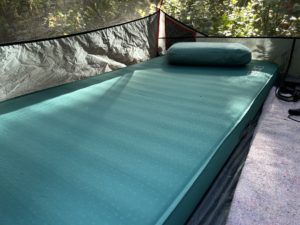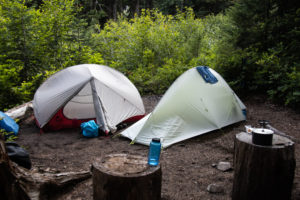Small backpacks are great for day hikes and travelling but when it comes to staying out in the backcountry for multiple days we need something a bit bigger. It needs to hold our shelter like a tent, sleeping gear, food, water and clothes in a light enough package to carry for days straight.
Backpacking packs, or multi-day packs, are big enough to hold food and gear for a multiple days, sometimes a week or more. They are one of the first things you’ll likely purchase when setting up your backpacking kit.
On this page
Buying a Backpacking Pack
Capacity in litres
Every backpack has a size measured in litres. This is how much space is inside. Common sizes for backpacking are 50, 60 or 70 litres but the pack just has to be big enough to hold all your gear. If you have less gear, you can take a smaller pack.
If you are thinking of doing larger trips into the future, like 4-7 days, you’ll probably need a 60 or 70 litre pack. Most packs offer attachment points and webbing on the outside to lash other gear on if it just doesn’t fit inside.
Try to pack everything you need inside. Things fall off the outside, get caught on branches or get more wet than you’d like. Attach items to the outside only when you absolutely have to.
With a bigger pack comes the urge to fill it. You shouldn’t be taking the kitchen sink hiking. Only take the essentials.
Fit
Packs are usually sized based on their length. There will be a small, medium and large or small/medium and large/extra-large. Each manufacturer will have instructions on how to measure the length of your back to see which pack should fit you best.
Once you’ve got the pack size right, you can usually make minor adjustments to the shoulder strap height. This will help you dial in the exact fit you want. Fitting is easier when there’s a bit of weight inside
What you are looking for is to have the middle of the hip belts around your waist sit on the top of your hip bones. With the hip belts on the tops of your hip bones, the shoulder straps should comfortably come up and over your shoulders, staying in contact all the way over.
Once the pack is fitted properly, fill it up the rest of your gear or an equivalent amount of weight. With gear, food and water, packs can weigh 30 to 40 pounds or more. Spend as much time as you can with the pack on before you buy it, and before going on any trips to the backcountry. You don’t want to be in the middle of nowhere and find out the shoulder straps bearing 40 pounds don’t fit properly.
Weight vs Features
There will always be a trade off between weight and features. In a perfect world, we could have a featherweight pack with all the whizbangs and doodads.
Here’s a list of features a pack may have that adds functionality but also adds weight.
-
Shoulder strap and waist belt padding
-
External pockets
-
Webbing and attachment points
-
Included pack cover
-
Internal frame
Always try to get the lightest pack possible with the features you need. You may be happy paying a little extra cost in weight for a bit more padding or more external pockets.
Waterproofing
Most packs are not waterproof. They require some an accessory to make them waterproof. Usually people buy a thin waterproof cover called a pack cover. These need to be the right size for your pack. Sometimes they are included with your pack but often not.
Another option is to put everything in waterproof bags like a garbage bag or drybags inside your pack. The pack will get wet but it won’t matter since everything inside is waterproof.
Pack covers are a bit like rain jackets. Some trips you won’t need to use them at all. Others, you’ll use them the entire time. Backpacking in the Pacific Northwest it’s a requirement any time of the year.
Glossary
Pack Cover – A waterproof cover that covers the whole pack. Rarely comes with the pack and usually comes separately.
Sternum Strap – The small chest-level strap that pulls the shoulder straps together.
Iliac Crest – The top of your hip bones. Waist belts on backpacks should be centered on this one for the most comfortable carry of a bigger pack.
Other Gear
You’ll need more than just a backpack to head out backpacking. Here are buying guides to all the other gear you need for backpacking.
- EXPED MegaMat LXW Sleeping Pad ReviewCamping is so much better when you get a good night sleep. With backpacking, hiking all day almost guarantees a good night sleep. But with… Read More »EXPED MegaMat LXW Sleeping Pad Review
- Backpacking Gear for Beginners CourseWelcome to the Backpacking Gear for Beginners Course. This course will walk you through every piece of hiking gear you might need for a short… Read More »Backpacking Gear for Beginners Course
- Backpacking Gear for Beginners: DishesThis post is part of the Backpacking Gear for Beginners course. Why do you need dishes? You probably want to eat while you’re backpacking, right? That usually… Read More »Backpacking Gear for Beginners: Dishes
- Backpacking Gear for Beginners: MapThis post is part of the Backpacking Gear for Beginners course. Why do you need a map? Navigation is one of the 10 Essentials. You… Read More »Backpacking Gear for Beginners: Map
- Backpacking Gear for Beginners: Notebook and PenThis post is part of the Backpacking Gear for Beginners course. Why do you need a notebook and pen? I love taking notes of what happened on… Read More »Backpacking Gear for Beginners: Notebook and Pen
- Backpacking Gear for Beginners: CompassThis post is part of the Backpacking Gear for Beginners course. Why do you need a compass? Some maps show trails, lake names and mountain… Read More »Backpacking Gear for Beginners: Compass
- Backpacking Gear for Beginners: Coffee MakerThis post is part of the Backpacking Gear for Beginners course. Why do you need a coffee maker? I don’t go far without my Aeropress coffee maker… Read More »Backpacking Gear for Beginners: Coffee Maker
- Backpacking Gear for Beginners: CameraWhy do you need a camera? Another optional piece of gear. I don’t go on many trips without a camera though. It’s an excellent tool… Read More »Backpacking Gear for Beginners: Camera
- Backpacking Gear for Beginners: Trekking PolesThis post is part of the Backpacking Gear for Beginners course. Why do you need trekking poles? Trekking poles are walking sticks with soft handles,… Read More »Backpacking Gear for Beginners: Trekking Poles
- Backpacking Gear for Beginners: Water filter, drops and tabletsThis post is part of the Backpacking Gear for Beginners course. Why do you need a water filter? No matter where you are, there’s a chance the… Read More »Backpacking Gear for Beginners: Water filter, drops and tablets
- Backpacking Gear for Beginners: RopeThis post is part of the Backpacking Gear for Beginners course. Why do you need rope? Rope can be a very useful thing to have on the… Read More »Backpacking Gear for Beginners: Rope
- Backpacking Gear for Beginners: HeadlampThis post is part of the Backpacking Gear for Beginners course. Why do you need a headlamp? Around camp and possibly on the trail, you’ll… Read More »Backpacking Gear for Beginners: Headlamp
- Backpacking Gear for Beginners: FoodThis post is part of the Backpacking Gear for Beginners course. Why do you need food? Well, we need food to survive so I guess we’re taking… Read More »Backpacking Gear for Beginners: Food
- Backpacking Gear for Beginners: MusicThis post is part of the Backpacking Gear for Beginners course. Why do you need a music player? You don’t. If you like music and it’s going… Read More »Backpacking Gear for Beginners: Music
- Backpacking Gear for Beginners: WatchThis post is part of the Backpacking Gear for Beginners course. Why do you need a watch? Having a watch on the trail, even a… Read More »Backpacking Gear for Beginners: Watch
- Backpacking Gear for Beginners: Hiking ClothesThis post is part of the Backpacking Gear for Beginners course. Clothes for hiking are an important part of staying warm, dry, comfortable, and safe. Pick your… Read More »Backpacking Gear for Beginners: Hiking Clothes
- Backpacking Gear for Beginners: Satellite Communicators and Emergency Locator BeaconsThis post is part of the Backpacking Gear for Beginners course. Why do you need a satellite communicator? First off, what is a satellite communicator or messenger?… Read More »Backpacking Gear for Beginners: Satellite Communicators and Emergency Locator Beacons
- Backpacking Gear for Beginners: Pack CoverThis post is part of the Backpacking Gear for Beginners course. Why do you need a pack cover? A pack cover is a waterproof cover… Read More »Backpacking Gear for Beginners: Pack Cover
- Backpacking Gear for Beginners: BaselayersThis post is part of the Backpacking Gear for Beginners course. Why do you need base layers? The base layer, or underwear layer, is the first layer… Read More »Backpacking Gear for Beginners: Baselayers
- Backpacking Gear for Beginners: Bear SafetyThis post is part of the Backpacking Gear for Beginners course. Why do you need bear safety gear? There are a couple items related to bears that… Read More »Backpacking Gear for Beginners: Bear Safety
Questions
Do you have any questions about backpacking packs? Let’s hear them below!

